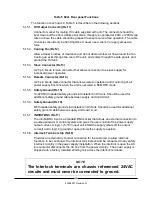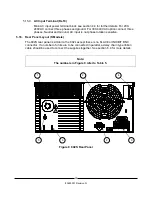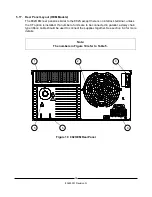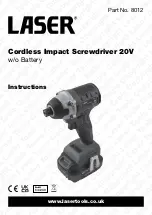
11
83488001 Revision N
3. OUT OF BOX INSPECTION
3.1.
Visual Inspection
Prior to shipment, this instrument was inspected and found to be free of mechanical and
electrical defects. As soon as the unit is unpacked, inspect for any damage that may have
occurred in transit. Verify the following:
a) Check the operation of the front panel control (knob should rotate smoothly).
b) Confirm that there are no dents or scratches on the panel surfaces.
c) Check front panel meters and LEDs for any broken or cracked lenses.
If any damage is found, follow the instructions in Section 3.3.
3.2.
Electrical Inspection
Before the power supply is installed in a system, verify that no internal damage occurred
during shipping. A set of simple preliminary electrical test can be performed if desired. These
tests are described below.
NOTE
The sequences described are for L model supplies with local controls, for S and OEM
models the corresponding signals must be applied and monitored through the remote control
interface.
3.2.1.
Test 1
Purpose:
Verify general logic operation, generate maximum output current, and check
overload protection circuits. With AC power "OFF" and disconnected, short the HV
output by connecting the center conductor of the output cable to its return shield
(braid). This dead short will allow the unit to generate full output current at zero voltage.
1. Set the output voltage control to zero. Connect AC power to the unit. Turn "ON" the
AC power front panel switch.
2. Turn the front panel keyswitch to the LOCAL position (if applicable). Press the HV
"ON" button and turn up the HV control until the power supply is generating output
current into the dead short. The current meter will indicate max. current. The
voltage meter will read zero and the power supply will intermittently turn on and off
indicating the "overload" condition. The unit should continue to indefinitely cycle in
this mode with a 1 second period. (The power supply will go into overload when
max. current is drawn for more than half a second). If the LP option is installed, the
unit will shut down and indicate a fault after delivering full current for 500milliS.
3. Turn off the HV and AC power switches.
This test indicates the inverter section is generating maximum current and the logic and
overload circuitry works correctly.
3.2.2.
Test 2
Purpose:
Verify that the power supply generates maximum rated voltage, and the
regulation and feedback circuits are functioning.
1. With AC power OFF and disconnected, connect an appropriate load capacitor to
the power supply output cable. Select the capacitor size so the charge time is
several milliseconds or more.
2. Prepare to charge the capacitor. NOTE: Operating a 802 power supply into an open
circuit (no load operation) will instantly damage the power supply's HV output
Summary of Contents for 802 Series
Page 2: ...PAGE LEFT INTENTIONALLY BLANK ...
Page 10: ...4 83488001 Revision N Notes ...
Page 34: ...28 83488001 Revision N Notes ...
Page 44: ...38 83488001 Revision N Notes ...
Page 57: ......
Page 58: ......
Page 59: ......
Page 60: ......
Page 61: ......
Page 62: ......
Page 63: ......
Page 64: ......
Page 65: ......
Page 66: ......
Page 67: ......
Page 68: ......
Page 69: ......
Page 70: ......
Page 71: ......
















































